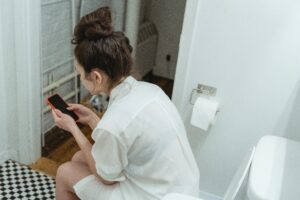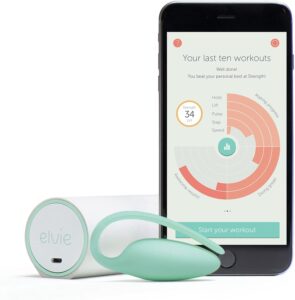Incontinence is the lack of voluntary control over urination or defecation. First line treatments for incontinence depend on individual circumstances and this needs to be discussed with a qualified healthcare provider.
Symptoms:
The American College of Obstetricians and gynaecologists splits incontinence into 3 categories –
-
Stress urinary incontinence: This type occurs with pressure on the bladder, such as when coughing, laughing, sneezing, or with physical activities such as running, jumping, or exercising.
-
Urgency urinary incontinence: This type is a sudden, uncontrollable urge to urinate, which usually results in leakage on the way to the bathroom.
-
Mixed incontinence: A mixture of both stress and urgency.
It is thought that 4 in 10 women will experience some form of postnatal incontinence. Stress incontinence is the most common type seen postnatally.
Causes:
-
During pregnancy, the weight of the expanding uterus can weaken the strength of a woman’s pelvic floor muscles and cause urine to leak.
-
Smoking has been linked to an increased likelihood of postnatal incontinence.
-
Women with a higher body mass index (BMI) during and after pregnancy have a higher chance of incontinence after childbirth.
-
There is a 50% increased risk of postnatal incontinence in women who give birth vaginally over those that have a c-section.
-
Damage to the nerves that control the bladder, rectum and pelvic floor muscles can affect the sensation to the bladder and lead to some forms of incontinence.
-
Having an episiotomy or experiencing a tear in the pelvic floor muscle during delivery.
-
Undergoing an assisted vaginal delivery with either forceps or a vacuum can increase the chances of urinary or faecal incontinence.
Here is what the evidence says about the treatment options (before any sort of surgical intervention is usually considered):
Pelvic Floor strengthening exercises – Many studies have shown the effectiveness in pelvic floor exercises when it comes to improving incontinence symptoms. THIS study found that pelvic floor training exercises could cure or improve symptoms of stress incontinence in particular but also were effective on all other types of urinary incontinence. They found that the exercises could reduce the number of leakage episodes and the quantity of leakage. THIS study also agreed that the pelvic floor training exercises worked well but they had added success when ‘biofeedback’ and vaginal cones were also used.
There is a brilliant app called Squeezy. This app shows you exactly how to do your pelvic floor exercises and for how long, tailored to each individual. Take a look at their website HERE for some really useful information on pelvic floor health.

Biofeedback – There is quite a lot of research into the effectiveness of biofeedback when it comes to conditions associated with a weak pelvic floor. THIS study concluded that, when comparing biofeedback to pelvic floor muscle training alone, the results were far superior using the feedback device. Biofeedback therapy builds on strength training by incorporating the use of equipment to record or amplify activities of the body and feed the information back to the patients. It can make doing pelvic floor exercises a little more fun / interesting and gives you a target and feedback on how much improvement there has been.
You could speak to your women’s health specialist Physiotherapist about using biofeedback devices, they are available to buy online. THIS is a one we would recommend based on its fantastic reviews.
Vaginal Cones – These are weighted toners which come in different sizes to help strengthen the pelvic floor muscles. They are designed to improve strength over a 12 week period, they’re easy to use and the ideal introduction to pelvic floor exercises. This study showed a better result when using biofeedback and toning cones, over just pelvic floor exercises on their own.
You can buy weighted cones / toners online HERE, they have excellent reviews. Always speak to your healthcare provider before using anything like this to check that it is the right course of treatment for you.
Bladder training – Bladder training is a way of teaching your bladder to hold more urine and aims to reduce the number of times you need to pass urine per day. The basic principle is that you hold off going to the toilet for increasing amounts of time, each time you feel you need to go (over the course of weeks or months). However, there has been little evidence found for the effectiveness of bladder training when it comes to urinary incontinence in post partum women. THIS study found that bladder training might be helpful but the trials reviewed were of variable quality and of small size.
Electrical stimulation – evidence suggests that nerve stimulation is effective in treating urge urinary incontinence. Nerve stimulation often involves surgical implantation of a device that sends a low-voltage electrical current to a nerve that controls the bladder and pelvic floor.
Pessary – Studies have shown that long-term pessary use is a safe and effective option for patients with pelvic organ prolapse and stress urinary incontinence. THIS (more recent) study documented that vaginal pessaries provide an adequate control of stress urinary incontinence if they are fitted properly and managed by frequent replacements and regular check-ups. They concluded that the pessary should be considered among the first line of treatment for incontinence along with exercise.
Pilates – evidence does support the use of Pilates-based exercise during & after pregnancy for the treatment of many conditions including pelvic floor strength. Evidence has also shown that Pilates can also have a positive effect on the birth and the outcome following the birth. This study compared Pilates with standard pelvic floor exercises and concluded that the Pilates exercise program was as effective as conventional pelvic floor exercises in speeding up continence recovery and it also achieved a higher rate of fully continent patients in the short-term.
Also, this small-scale study looked into the use of Pilates based exercise in incontinence sufferers and reported some really positive results. Pilates includes the pelvic floor training and also aims to give the whole body a work out rather than just targeting one area (like in pelvic floor training).
Have a look at our Top 5 online Pilates options here.
Really helpful links we think you’ll love:
Here is a link to a really informative video that explains pelvic floor dysfunction and incontinence really well.
What symptoms to watch out for:
If you have any of the following symptoms then go to your nearest accident and emergency department immediately:
-
Severe low back pain.
-
Pain, numbness, or weakness in one or both legs that causes you to stumble or have trouble getting up from a chair.
-
Loss of or altered sensations in your legs, buttocks, inner thighs, feet or areas that you sit on when in a chair (including genitals / anus) that is severe or gets worse and worse.
-
Recent problem with bladder or bowel function, such as trouble eliminating urine or waste (retention) or trouble holding it (incontinence).
-
Sexual dysfunction that has come on suddenly.



